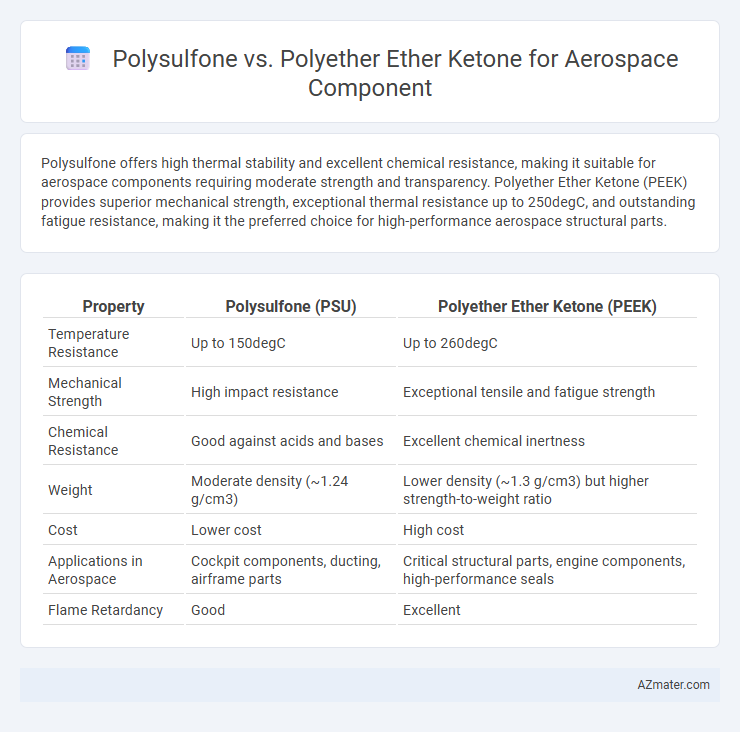Polysulfone offers high thermal stability and excellent chemical resistance, making it suitable for aerospace components requiring moderate strength and transparency. Polyether Ether Ketone (PEEK) provides superior mechanical strength, exceptional thermal resistance up to 250degC, and outstanding fatigue resistance, making it the preferred choice for high-performance aerospace structural parts.
Table of Comparison
| Property | Polysulfone (PSU) | Polyether Ether Ketone (PEEK) |
|---|---|---|
| Temperature Resistance | Up to 150degC | Up to 260degC |
| Mechanical Strength | High impact resistance | Exceptional tensile and fatigue strength |
| Chemical Resistance | Good against acids and bases | Excellent chemical inertness |
| Weight | Moderate density (~1.24 g/cm3) | Lower density (~1.3 g/cm3) but higher strength-to-weight ratio |
| Cost | Lower cost | High cost |
| Applications in Aerospace | Cockpit components, ducting, airframe parts | Critical structural parts, engine components, high-performance seals |
| Flame Retardancy | Good | Excellent |
Introduction to Aerospace Polymers
Aerospace polymers such as Polysulfone (PSU) and Polyether Ether Ketone (PEEK) are crucial for manufacturing high-performance components due to their exceptional thermal stability, mechanical strength, and chemical resistance. Polysulfone offers excellent toughness and dimensional stability at elevated temperatures around 160degC, making it suitable for interior aircraft parts and ducts. Polyether Ether Ketone outperforms with a higher continuous service temperature near 260degC, superior fatigue resistance, and enhanced resistance to harsh chemicals, making it ideal for structural aerospace components exposed to extreme environments.
Overview of Polysulfone (PSU)
Polysulfone (PSU) is a high-performance thermoplastic known for its exceptional thermal stability, chemical resistance, and mechanical strength, making it suitable for aerospace components exposed to harsh environments. Its glass transition temperature typically ranges around 185degC, allowing PSU to maintain structural integrity under elevated temperatures. Compared to Polyether Ether Ketone (PEEK), PSU offers cost-effective solutions with good dimensional stability and flame retardant properties, though it has lower temperature resistance and mechanical performance.
Overview of Polyether Ether Ketone (PEEK)
Polyether Ether Ketone (PEEK) is a high-performance thermoplastic known for its exceptional mechanical strength, chemical resistance, and thermal stability, making it ideal for aerospace components exposed to extreme conditions. Its lightweight nature combined with a high melting point around 343degC enables durable performance in demanding environments where metals might fail. PEEK's superior fatigue resistance and dimensional stability under varying temperatures ensure reliability and longevity in critical aerospace applications compared to polysulfone.
Mechanical Properties Comparison
Polysulfone (PSU) exhibits high impact resistance and excellent thermal stability up to 150degC, making it suitable for moderate aerospace component applications requiring toughness and dimensional stability. Polyether Ether Ketone (PEEK) outperforms PSU with superior tensile strength of approximately 90-100 MPa and continuous service temperature up to 250degC, delivering exceptional fatigue resistance and chemical stability essential for critical aerospace parts subjected to extreme environments. The mechanical properties of PEEK make it the preferred choice for high-performance aerospace components demanding durability, strength-to-weight ratio, and long-term reliability under harsh mechanical and thermal stresses.
Thermal Stability and Performance
Polyether ether ketone (PEEK) demonstrates superior thermal stability compared to polysulfone (PSU), maintaining structural integrity at continuous operating temperatures up to 260degC, while polysulfone is limited to around 170degC. The high glass transition temperature and melting point of PEEK enable enhanced mechanical performance and resistance to thermal degradation in aerospace components exposed to extreme environments. These characteristics make PEEK a preferred choice for critical aerospace parts requiring high thermal endurance and long-term dimensional stability.
Chemical Resistance in Aerospace Environments
Polyether Ether Ketone (PEEK) exhibits superior chemical resistance compared to Polysulfone (PSU) in aerospace environments, withstanding aggressive fuels, hydraulic fluids, and solvents without degradation. PSU offers moderate resistance but is more susceptible to hydrolysis and chemical attack under prolonged exposure to harsh aerospace chemicals. The excellent chemical stability of PEEK ensures enhanced durability and reliability for critical aerospace components exposed to extreme conditions.
Weight and Density Considerations
Polysulfone (PSU) has a density of approximately 1.24 g/cm3, while Polyether Ether Ketone (PEEK) typically ranges around 1.30 g/cm3, making PSU slightly lighter for aerospace components where weight savings are critical. Despite PSU's weight advantage, PEEK offers superior mechanical strength and thermal resistance, which can justify its marginally higher density in high-performance applications. Careful evaluation of component function and environmental exposure is essential to optimize the weight-to-strength ratio in aerospace designs.
Manufacturing and Processing Differences
Polysulfone (PSU) offers ease of thermoforming and injection molding, making it suitable for rapid prototyping in aerospace components, whereas Polyether Ether Ketone (PEEK) requires high-temperature processing with specialized equipment due to its melting point above 340degC. PSU's lower processing temperature reduces energy consumption and cycle time, but PEEK provides superior thermal stability and chemical resistance required for aerospace environments. Manufacturing with PEEK demands precise control of cooling rates to prevent crystallization issues, contrasting with PSU's more forgiving processing parameters.
Cost Analysis: PSU vs PEEK
Polysulfone (PSU) offers a significantly lower material cost compared to Polyether Ether Ketone (PEEK), making it a budget-friendly option for aerospace components with moderate performance requirements. However, PEEK's superior mechanical strength, chemical resistance, and thermal stability justify its higher price in critical aerospace applications where durability and reliability are paramount. Cost analysis must balance PSU's affordability against PEEK's long-term performance benefits to determine the optimal material selection for specific aerospace component needs.
Application Suitability in Aerospace Components
Polyether Ether Ketone (PEEK) offers superior thermal stability, chemical resistance, and mechanical strength compared to Polysulfone, making it highly suitable for critical aerospace components exposed to extreme temperatures and harsh environments. Polysulfone provides good toughness and impact resistance at a lower cost, often used in non-structural or secondary aerospace parts where moderate mechanical and thermal properties suffice. The selection between PEEK and Polysulfone depends on specific aerospace requirements such as weight reduction, fire resistance, and long-term durability under operational stresses.

Infographic: Polysulfone vs Polyether Ether Ketone for Aerospace Component
 azmater.com
azmater.com